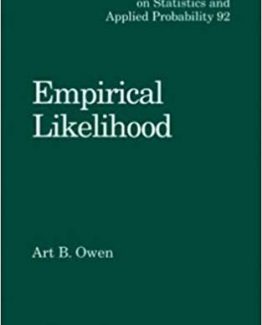The Analysis of Biological Data 3rd Edition by Michael C. Whitlock, ISBN-13: 978-1319226237
[PDF eBook eTextbook]
- Publisher: W. H. Freeman; Third edition (January 6, 2020)
- Language: English
- 848 pages
- ISBN-10: 131922623X
- ISBN-13: 978-1319226237
The Analysis of Biological Data provides students with a practical foundation of statistics for biology students. Every chapter has several biological or medical examples of key concepts, and each example is prefaced by a substantial description of the biological setting. The emphasis on real and interesting examples carries into the problem sets where students have dozens of practice problems based on real data.
The third edition features over 200 new examples and problems. These include new calculation practice problems, which guide the student step by step through the methods, and a greater number of examples and topics come from medical and human health research. Every chapter has been carefully edited for even greater clarity and ease of use. All the data sets, R scripts for all worked examples in the book, as well as many other teaching resources, are available to qualified instructors (see below).
The Analysis of Biological Data is a new approach to teaching introductory statistics to biology students. To reach this unique audience, Whitlock and Schluter motivate learning with interesting biological and medical examples; they emphasize intuitive understanding; and they focus on real data. The book covers basic topics in introductory statistics, including graphs, confidence intervals, hypothesis testing, comparison of means, regression, and designing experiments. It also introduces the principles behind such modern topics as likelihood, linear models, meta-analysis and computer-intensive methods. Instructors and students consistently praise the book’s clear and engaging writing, strong visualization techniques, and its variety of fascinating and relevant biological examples.
Table of Contents:
About the authors
Acknowledgments
SaplingPlus for statistics
Online resources for students
PART 1 INTRODUCTION TO STATISTICS
1. Statistics and samples
INTERLEAF 1 Correlation does not require causation
2. Displaying data
3. Describing data
4. Estimating with uncertainty
INTERLEAF 2 Pseudoreplication
5. Probability
6. Hypothesis testing
INTERLEAF 3 Why statistical significance is not the same
as biological importance
PART 2 PROPORTIONS AND FREQUENCIES
7. Analyzing proportions
INTERLEAF 4 Biology and the history of statistics
8. Fitting probability models to frequency data
INTERLEAF 5 Making a plan
9. Contingency analysis: Associations between categorical
variables
Review Problems 1
PART 3 COMPARING NUMERICAL VALUES
10. The normal distribution
INTERLEAF 6 Controls in medical studies
11. Inference for a normal population
12. Comparing two means
INTERLEAF 7 Which test should I use?
13. Handling violations of assumptions
Review Problems 2
14. Designing experiments
INTERLEAF 8 Data dredging
15. Comparing means of more than two groups
INTERLEAF 9 Experimental and statistical mistakes
PART 4 REGRESSION AND CORRELATION
16. Correlation between numerical variables
INTERLEAF 10 Publication bias
17. Regression
INTERLEAF 11 Meta-analysis
Review Problems 3
PART 5 MODERN STATISTICAL METHODS
18. Analyzing multiple factors
INTERLEAF 12 Using species as data points
19. Computer-intensive methods
20. Likelihood
21. Survival analysis
Statistical tables
Literature cited
Answers to practice problems
Index
Michael Whitlock is an evolutionary biologist and population geneticist. He is a professor of zoology at the University of British Columbia, where he has taught statistics to biology students since 1995. Whitlock is known for his work on the spatial structure of biological populations, genetic drift, and the genetics of adaptation. He has worked with fungus beetles, rhinos, and fruit flies; mathematical theory; and statistical genetics. He is a fellow of the American Academy of Arts and Sciences and a fellow of the American Association for the Advancement of Science. He is also the former editor-in-chief of The American Naturalist.
Dolph Schluter is professor and Canada Research Chair in the zoology department and Biodiversity Research Center at the University of British Columbia. He currently teaches evolutionary ecology as well as a graduate course in biological data analysis. He is a fellow of the Royal Society of London and the Royal Society of Canada and is a Foreign Member of the American Academy of Arts and Sciences. He has received multiple honors including the Guggenheim Fellowship, The Sewall Wright Award from the American Society of Naturalists, the Killam Fellowship from the Canada Council, and the Darwin-Wallace Medal from the Linnean Society of London.
What makes us different?
• Instant Download
• Always Competitive Pricing
• 100% Privacy
• FREE Sample Available
• 24-7 LIVE Customer Support





